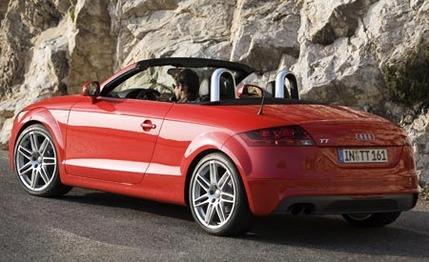
 First Drive Review
First Drive Review
The roadster version of Audi's new TT comes as no surprise, considering that the old TT also came in hard- and soft-top variants. But the TT roadster still has a few good tricks rolled up its sleeve that are worth mentioning. The first is something you can't see, but you can feel it. On the roadster, the structure that runs underneath the door is made of thicker aluminum, with more internal reinforcement than the coupe, but the outside shape is identical to that of the coupe. Reinforcing the side-sill structure in this way to compensate for the loss of the roof - instead of using heavy cross-bracing - makes the new TT roadster lighter than the outgoing 2006 model (there will be no 2007 in the U.S.) but Audi claims a 120-percent increase in structural stiffness. We won't know exactly how many pounds the open TT saves until the car arrives here in late 2007, but extensive use of aluminum throughout the front structure could shave as much as 300 pounds. Pricing is unknown at this point as well, but it should be close to the outgoing model - base price should start around $36,000 and fully-loaded model will get close to 50 grand.
Common ground
Conceptually, the TT roadster shares a lot with the previous version, even though the structure and styling are all-new. As before, Audi fit the TT with a soft top with a glass rear window, and the top stows where the tiny rear seats are located in the coupe. Base models on the European-spec cars come with a manually-operated top but the power-operated top, which automatically unlatches and folds the roof in 12 seconds, should be standard on all U.S. models.
Powertrain choices are the same as for the TT coupe: a 200-horsepower 2.0-liter turbo four or a 250-horsepower 3.2-liter V-6. The four cylinder comes with a either a six-speed manual transmission or a six-speed known as S-tronic (it was called DSG on the outgoing TT). The S-tronic automatic is actually a dual-clutch sequential manual that can be paddle shifted or left to its own devices in automatic or sport-program automatic mode. The V-6 can only be had with S-tronic. At first, the 2.0-liter will be front-wheel-drive only; customers looking for Quattro all-wheel drive will have to step up to the V-6. Of the three configurations, we prefer the 2.0T with the S-tronic automatic. The front wheels occasionally struggle with grip when the turbo hits full boost, but the lighter weight, louder burbling exhaust, and lower price more than compensate for the lack of all-wheel-drive. The V-6 is about a half a second quicker in the run from 0 to 60 mph, and with 236 pound-feet of torque available from 2,500 rpm, midrange response is instantaneous. It's also smoother and quieter than the four-cylinder, but really it's almost too quiet. If the rest of the TT convertible wasn't so hushed, the V-6 would be barely audible.
With the top up, barely any wind noise intrudes on the cabin. Some road noise comes through behind the driver's head, where the soft top offers less noise protection than the glass window, but overall the TT is very quiet. A power-operated mesh wind blocker cuts down on noise when the top is down.
Wobbly no more
On our preview drive outside of Nice, France, the TT roadster seems wider than it actually is due to the narrow, cramped roads that run along the Mediterranean Sea, but the TT will fit fine on American roads, and American drivers will appreciate the roomy cabin. The steering is light but precise, as is the case with the Audi A3, which shares a lot of its underpinnings with the TT. We drove cars fitted with Audi's magnetic ride dampers (also known in GM vehicles as MagnaRide). It's an option that should be included on any purchase order, as it keeps chassis motions well controlled. The Volkswagen GTI and Audi A3, which share a similar platform and the same powertrain options, still manage a good ride without the advanced shock absorbers, but that's probably due to a stiffer chassis since both cars have a full roof. On the TT, setting the dampers in "sport" mode tightens us the ride and sharpens turn-in so much that the "normal" mode makes the car feel sloppy, but the ride was still smooth over slightly rough roads. The electronically power-assisted steering is light but precise, and the flat-bottomed steering wheel (similar to the one found on the R8) has bumps and indentations in all the right places. From an overall driving standpoint, the old TT convertible doesn't compare: the new model feels like a complete car, while the old one made you constantly question whether the convertible top was worth the excessive understeer and wobbly chassis.
When the TT roadster arrives next year, comparisons to the BMW Z4, Porsche Boxster, and Mercedes-Benz SLK are inevitable. Although the new Audi is clearly sportier than the car it replaces, it's still not as focused on performance as some of its rivals. We'll withhold overall judgment until we can conduct a comparison test, but to design mavens the TT wins on style regardless of how it drives. For those who like to make a fashion statement as much as they enjoy open-air driving, the TT is the perfect car.